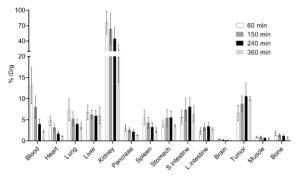A group from Department of Gastrointestinal and Hepato- Biliary- Pancreatic Surgery, Faculty of Medicine, University of Tsukuba, Tsukuba, Japan, etc. has reported about PET imaging targeting cell surface glycans for pancreatic cancer using a 18F-labeled rBC2LCN lectin.
https://onlinelibrary.wiley.com/doi/epdf/10.1111/cas.15846
In this study, the potential application of an rBC2LCN–fluorine-18 (18F) conjugate was explored as a novel positron emission tomography (PET) probe. Capan-1, an H-type-3-positive human pancreatic cancer cell line, was was selected and Capan-1 cells (2×106) were injected subcutaneously into the right dorsa of nude mice. It is known that rBC2LCN lectin has a binding specificity to H-type-3 glycan. Importantly, rBC2LCN does not induce hemagglutination (induced when exogenous lectins are introduced into the blood), allowing it to be harmlessly admin-istered intravenously.
As aresult, it was shown that 18F-labeled rBC2LCN lectin offers a novel class of tumor-specific probes for PET that are based on targeting cell surface glycans. However, I feel that this probe is actually specific to cancer cells, but it might be a problem to know that this binds to other normal tissues as well as shown below.

